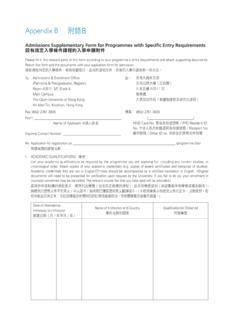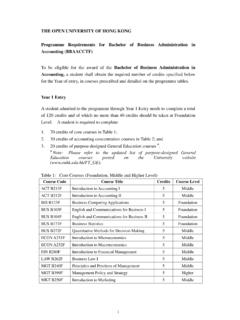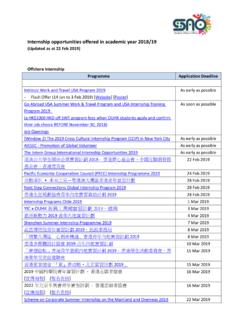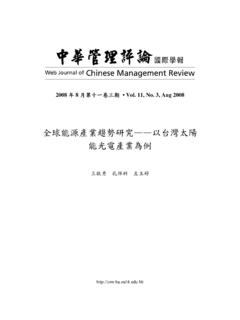Transcription of THE UNIVERSITY OF ZAMBIA LIBRARY: PAST, …
1 1 THE UNIVERSITY OF ZAMBIA library : PAST, PRESENT ANDTHE FUTUREDr. Hudwell MwacalimbaUniversity LibrarianThe UNIVERSITY of ZAMBIA , ZambiaEmail: UNIVERSITY OF ZAMBIA library : GENERAL OVERVIEWZ ambiau The Republic of ZAMBIA is a landlocked country in central Southern Former British Was called Northern Rhodesia prior to gaining independence in October Yearsu Part of the Federation of Rhodesia and Nyasaland from 1953 to 1963 The hodesias comprised Northern Rhodesia (present day ZAMBIA ); Southern Rhodesia(present day Zimbabwe) while Nyasaland is the present day is a landlocked country which shares borders with Angola, Botswana, Namibia,Democratic Republic of the Congo, Tanzania, Malawi, Mozambique and ZAMBIA has a population of about 10 73 ethnic tribes.
2 English is the official language but there are seven (7) local languages used on thenational radio and television broadcasting; namely: Bemba, Nyanja, Tonga, Lozi, Luvale,Lunda and Copper mining (declining due to low world copper prices) stay of the Agricultural exportsu Tourismu Manufacturing industry weakened by cheaper imports2 THE UNIVERSITY OF ZAMBIAu Set up in 1965, one year after gaining independence from Located in Lusaka, the capital cityu Has a student population of some 4,500 excluding 500 distance Predominantly an undergraduate universityu Postgraduate programmes on the The following schools constitute the UNIVERSITY of ZAMBIA .
3 U Agricultural Sciencesu Educationu Engineeringu Humanities and Social Sciencesu Lawu Minesu Natural Sciencesu Medicineu Veterinary MedicineDirectorates/Instituteu Directorate of Research and Postgraduate Studiesu Directorate of Distance Educationu Institute of Economic and Social Research (INESOR)The UNIVERSITY of ZAMBIA library : General Overviewu Historical Backgroundu Established in 1965 initially at the Ridgeway campus, now housing Medical Schoolu Moved to the current building on 27 August 1969u Declared national reference for ZAMBIA on official opening on 27 August 1969 MissionTo provide an environment in which the UNIVERSITY can conduct its core function ofteaching, research and the provision of informed public the Main library Veterinary library the Medical LibraryDivisions Readers Services3 Special Collections Technical Services (Cat.)
4 & Class., Serials, Acquisitions) Bindery and Photographic UnitsLibrary Collectionu 170,000 volumesu About 1200 journal titlesu Most of the collection is too old due to lack of funds to replenish itu No budget for book purchases or periodical subscriptions in the past 8 yearsu CD-ROM facilities/Internet compensating for lack of current journal subscriptionsLibrary Automation: Initial Effortsu Interest in the computerisation of the library dates back to 1974u In 1975, with the assistance of the Computer Centre all the periodical holdings weremanually entered onto A3 coding sheetsGood Progress Made u By late 1975 nearly 25% of the journal titles were keyed onto IBM punched cards usingPL/1 high level languageu The Computer Centre personnel did data entry and even produced test resultsChange of PersonnelIn 1975 the person who initiated the automation process in the UNIVERSITY library wastransferred to the Department of library Studies as Lectureru He continued to supervise the library
5 Automation exerciseu In 1976 there was change of top leadership in the UNIVERSITY of ZAMBIA Exercise AbandonedFrom 1977 to 1981, the person who had spearheaded the computerisation of periodicalswas out of the country pursuing further studiesu During that period, the library automation exercise was abandoned due to lack ofsupport from the top library leadershipAutomation Suffers Further Setback u The IBM punched data cards were thrown away, and so were the 75% of the manuallycoded A3 sheetsu That marked the end of the initial initiative41984 Stock Taking Exerciseu In 1984 the UNIVERSITY library conducted a major stock taking exerciseu The purpose of the exercise was to determine how many books were in the library to determine the value of UNIVERSITY library books as fixed assetsu The exercise was spearheaded by the Bursar's officeData EntryTo obtain such information the Computer Centre was requested to design a file structurefor the Assets Register.
6 library Books The manual data entry was done by library staff while the Computer Centre did thedata processingUnsuitable File Structure u The file structure used for the Assets Register was unsuitable for library useu Major short comings included missing key fields like subject, ISBN, publisher lengths for Author and Title were too short and thus made it virtually impossible todistinguish one title from another in a sorted Local DatabasesIn 1990 the UNIVERSITY library started creating its own in-house local databases to solvespecific library management problems using our little knowledge of dBase PlusBy using personal computers in other Sections of the UNIVERSITY , the library hasdeveloped dBase Applications for managing the following Short Loan Collection (SLC)
7 Consists of nearly 3000 reading materials in short supply recommended by teaching stafffor courses being taught in the current academic yearPrinted indexes are produced for students to identify materials they require for aparticular course listed under a particular Lecturer nameOutputu SLC Indexes are printed for: the Main library the Veterinary library the Medical library the entire library systemu Online retrieval is available5 Serials Managementu This is a list of all journals held in UNZA LibraryOutputu Indexes are printed for the Main library the Veterinary the Medical library the entire library systemu Online retrieval is availableNewspaper Indexing (dBase version)u This started as an experimental newspaper indexing project earlier this year (1999).
8 U Articles appearing in selected local newspapers are indexedu Descriptors for each article are freely picked from the article A printed index can be generated at any timeu Online retrieval is availableDemand drivenThe newspaper database was developed for newspaper articles indexing uponexperiencing difficulties (by staff and researchers) in retrieving information from Demand for news information has increased as a result of the newspaper indexedThese include Times of ZAMBIA , Sunday Times of ZAMBIA , ZAMBIA Daily Mail, SundayMail, The Monitor, The Post (online) and National Indexing (CDS-ISIS Version)u The news database contains newspaper articles indexed from the Zambian daily andweekly The newspapers covered are limited to those titles received by the UNIVERSITY library .
9 U This could be a limitation6 Demand drivenThe newspaper database was developed for newspaper articles indexing uponexperiencing difficulties (by staff and researchers) in retrieving information from Demand for news information has increased as a result of the newspaper indexedThese include Times of ZAMBIA , Sunday Times of ZAMBIA , ZAMBIA Daily Mail, SundayMail, The Monitor, The Post (online) and National Monitoring Systemu This consists of an inventory of all the equipment in the library such as computersDesigned to provide information on every piece of equipment in the library such aslocation, type of equipment, serial number, model number, condition information can be used to trace stolen library equipment and for other purposesOutputu List of all equipment in the Libraryu List of all computers in the Libraryu List of all equipment (by library )
10 Main library Veterinary library Medical library Entire library Systemu Labels for all equipment in the LibraryOnline searching byu Equipment nameu Serial Numberu Model Numberu Part NumberAIM DatabaseThe African Index Medicus (AIM) database is an index to health literature generated inand by African countries including ZAMBIA . It is created in CDS-ISISAIM database is printed and distributed to member countries and to organisations outsidethe region. It is accessible on the Internet from the Medical library web for Health Information and Libraries in Africa (AHILA) with







